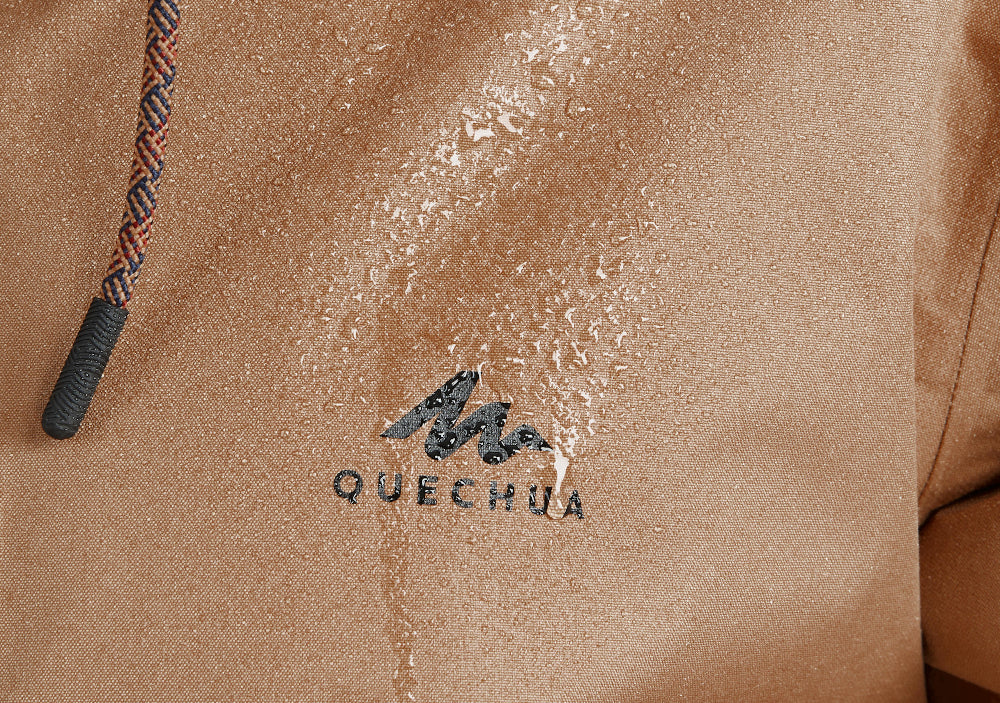
Who we are: Quechua waterproof jackets
Share
Our technology to fight bad weather
 Waterproofness
Waterproofness
Efficient protection against bad weather in the mountains against rain, snow, hail, dew, and humidity
Our componentsWe measure the fabric resistance with a water pressure replicated with millimeter water columns (tests based on the ISO 811 norm). The higher the pressure, the more the fabric is considered waterproof. A component with a 2000mm waterproofness will resist pressure of 2000mm of water (the equivalent of a two-hour rainfall).
All our jackets are water-repellentThe water-repellency of a fabric is its ability to let water slip off its surface. This is achieved by treating the outside of the fabric. This treatment needs to be renewed during the clothing’s lifetime (we suggest every 3 washes). All Quechua raincoats have this water-repellent treatment.
Our shower testEach jacket is checked in a shower test under a certain amount of liters per m2 per hour over several hours hours (according to certain specificities). This test recreates a a mountain storm.

How to renew the water-repellency of a jacket
Your hiking jacket seems less waterproof than when you first used it? Don’t worry, here’s how to give it back its initial performance!
 Ventilation
Ventilation
Ventilation zips under the arms or on the chest to facilitate moisture evacuation
Our fabric's role
In addition to the breathability of the fabrics used, Quechua is developing technical solutions (zippers, aerations, mesh…) that improve the overall ventilation of all our jackets made for hiking. These ventilation systems allow for temperature regulation inside the jackets and to facilitate evacuation of sweat formed by the body during physical efforts.
The fabric
To know if a fabric is breathable, we measure its RET evaporation resistance (test based on the ISO 11092 norm). The lower the resistance, the more the fabric allows the vapor generated by the body in activity to be released, thus making it more breathable.
For example:
RET < 9 = extremely breathable fabric
9 < RET < 12 = very breathable fabric
12 < RET < 20 = breathable fabric
RET > 20 = not or less breathable fabric
Membraned or coated component
To make a fabric waterproof, there are two solutions:
The coating: it's a waterproof material spread on the inside of the fabric. It stops the penetration of water inside the item but can release the vapor formed by the body during physical efforts so you remain dry.
The membrane: it is a film applied on the inside of the fabric. It is waterproof and stops water coming from the outside but evacuates the sweat created by the body as it moves. The membrane is more flexible and durable than the coating.
Weight details
Hikers have to carry all of their equipment even on their more demanding hikes. That’s why we design our products so that they are the lightest possible ensure greater flexibility and freedom of movement.
Jehanne,
Textile designer
The most important thing in my job is to visually transcribe the 3 main functions of the item so that the sportsmen and women understand them instantly.
After the briefing with the product manager, I get my inspiration from the textile market but also from the environment in which the product will be used: here, the mountains.
Then I use a map of the body to determine where I need to place the seams in order to ensure freedom of movement during the hike. I suggest a few ideas that I then study with the prototype maker and the product engineer.
I keep in mind the general design directions to ensure visual coherence of the product within the brand.















